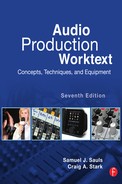Production Tip 1A—Pick Any Two
Production Tip 1B—Copy Marking
Project 1—Undertake Production Planning for a 15-Minute Interview Show
CHAPTER 2 THE STUDIO ENVIRONMENT
2.4 Production Studio Furniture
2.5 Studio Sound Considerations
2.6 Studio Construction Materials
Production Tip 2A—Static Electricity
2.12 Is it a Sound Signal or an Audio Signal?
2.14 Key Characteristics of Sound Waves
Project 1—Tour an Audio Facility and Write a Report Describing It
Project 2—Redesign Your Production Studio
Project 3—Draw an Audio Chain Flowchart for Your Production Studio
CHAPTER 3 DIGITAL AUDIO PRODUCTION
3.2 The Analog Roots of Digital Production
3.5 Desktop Audio Production: The Digital Audio Editor
3.6 Digital Audio Workstations and Other Digital Editors
3.7 Strong Points and Weak Points of Digital Production
Production Tip 3B—Maintaining Digital Equipment
3.11 Multitrack Editing Techniques
3.15 Multitrack Spot Production
Project 1—Undertake Digital Audio Editing
Project 3—Write and Record a 60-Second “Concert Commercial”
Project 4—Write and Record a Report that Compares Various Recording/Editing Software Programs
4.5 Microphone Pickup Patterns
4.6 The Omnidirectional Pickup Pattern
4.7 The Cardioid Pickup Pattern
4.10 Sensitivity of Microphones
4.11 Proximity Effect and Bass Roll-Off
4.13 Multiple-Microphone Interference
4.17 Special Purpose and Other Types of Microphones
Production Tip 4A—Microphone-to-Mouth Relationship and Setting Levels
Project 1—Position Microphones in Various Ways to Create Different Effects
Project 2—With Several Other Students, Make a Recording Using Stereo Miking Techniques
Project 3—Compare Sound from Different Types of Microphones
Project 4—Diagram/Apply Miking Techniques to Various On-Campus or Local Sporting Events
5.4 Computers and Audio Consoles
5.5 Basic Audio Console Components
5.8 Monitoring: Speakers and Headphones
5.13 Remote Starts, Clocks, and Timers
Production Tip 5A—Manipulating Faders
5.16 Sound Transitions and Endings
Project 1—Learn To Operate an Audio Console
Project 2—Diagram and Label an Audio Board
Project 3—Record a Two-Voice Commercial
CHAPTER 6 DIGITAL AUDIO PLAYERS/RECORDERS
6.6 Compactflash and Other Digital Recorders
6.8 MP3/Portable Audio Players
6.9 Digital Distribution Networks
Project 1—Record a Public Service Announcement that Uses a Sound Effect
Project 2—Prepare a Report on a Digital Player/Recorder that Is Not Discussed in This Chapter
Project 3—Play and Record Several CD Selections
CHAPTER 7 MONITOR SPEAKERS AND STUDIO ACCESSORIES
7.3 Basic Speaker System Components
7.4 Speaker System Enclosure Designs
7.7 Phase and Channel Orientation
7.13 Other Connectors and Connector Adapters
7.14 Balanced and Unbalanced Lines
7.15 Microphone, Line, and Speaker Levels
Project 1—Compare Speaker/Listener Placement
Project 2—Identify Common Connectors Found in the Audio Production Studio
CHAPTER 8 SIGNAL PROCESSING EQUIPMENT
8.2 Why Use Signal Processing Effects?
8.3 Software or Black Box Signal Processing
Production Tip 8A—World Wide Web Effects
8.11 Compressors, Expanders, and Noise Gates
Project 1—Record a Commercial Spot that Uses a Signal Processing Effect
Project 2—Use Multitrack Recording to Create a Chorusing Effect
Project 3—Restore an Audio Clip Using Noise-Reduction Software
CHAPTER 9 PRODUCTION SITUATIONS
Production Tip 9A—Music Punctuators
Production Tip 9B—Miking a Guitar
9.6 Preparing and Announcing News
9.7 Reporting Sports, Traffic, and Weather
9.9 Performing Drama and Variety
Project 1—Record an Air-Check Tape
Project 2—Record a 5-Minute Radio Interview Show in Which You Are the Interviewer
CHAPTER 10 LOCATION SOUND RECORDING
10.2 Types of Field Production
10.3 Common Location Sound Problems
Production Tip 10A—How to Get Rid of a Hum
10.4 Site Planning for Location Recording
10.9 Getting the Signal Back to the Studio
10.11 Providing for Your Own Needs
Production Tip 10B—How to Pack a Survival Bag
10.12 Postproduction Concerns for Location Recording
Project 1—Listen and Plan for Sounds
Project 2—Record Atmosphere Sound, Room Tone, and Walla Walla
CHAPTER 11 SOUND PRODUCTION FOR THE VISUAL MEDIA
11.2 The Importance of Sound to a Visual Production
11.3 The Need to Accommodate the Picture
Production Tip 11A—Holding a Fishpole
11.7 Other Forms of Microphone Positioning
11.8 Continuity and Perspective
Production Tip 11B—Recording with Your Eyes Shut
11.11 Recording Ambient Sounds
11.16 Postproduction Considerations
Project 1—Determine the Importance of Sound and Picture
Project 2—Record Sound for a Video Project
CHAPTER 12 INTERNET RADIO AND OTHER DISTRIBUTION PLATFORMS
Production Tip 12A—Love Manifests to Digital
12.3 Overview of the Audio Process for Streaming
12.6 Playback Software and Apps
Production Tip 12B—Internet Audience and On-Air Talent Interaction
12.8 On-Demand Files and Podcasting
12.9 Building a Home Studio for Internet Audio Production
12.11 Internet Radio Station Listing Sites
12.12 Other Distribution Means
12.14 Cable and Satellite TV Radio
12.15 Over-the-Air Broadcasting
Project 1—Report on the Differences and Similarities among Six Radio Station Websites
Project 2—Tour a Broadcast Radio Station Transmitting Facility
APPENDIX ANALOG AND DIGITAL AUDIO EQUIPMENT
A.4 Reel-to-Reel Audio Tape Recorders
A.10 Tape-Based Digital Recorders
